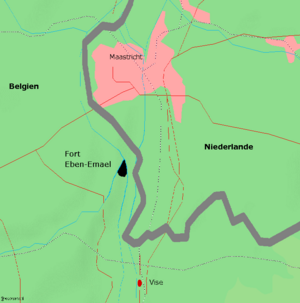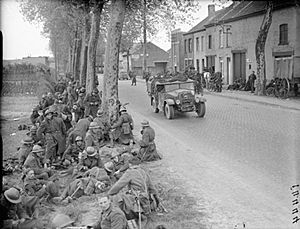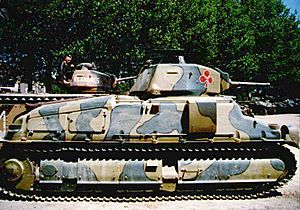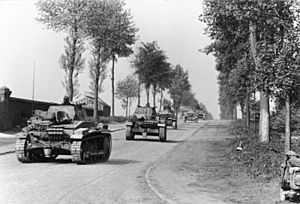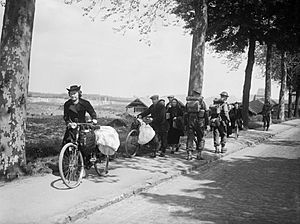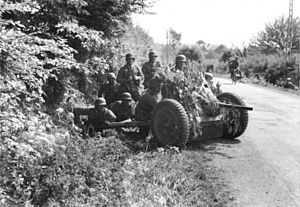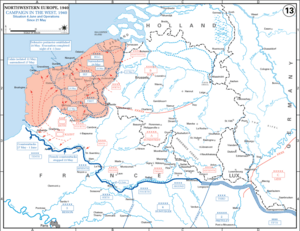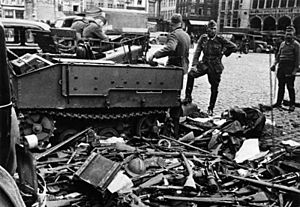German invasion of Belgium (1940) facts for kids
Quick facts for kids Battle of Belgium |
|||||||||
|---|---|---|---|---|---|---|---|---|---|
| Part of the German invasion of France and the Low Countries in World War II | |||||||||
 Belgian soldiers under German guard following the fall of Fort Eben-Emael on 11 May 1940. |
|||||||||
|
|||||||||
| Belligerents | |||||||||
| Commanders and leaders | |||||||||
| Strength | |||||||||
| 144 divisions 13,974 guns 3,384 tanks 2,249 aircraft |
141 divisions 7,378 guns 2,445 tanks 5,446 aircraft (4,020 operational) |
||||||||
| Casualties and losses | |||||||||
| 222,443+ casualties (200,000 captured) ~900 aircraft |
Uncertain (see German casualties) | ||||||||
The Battle of Belgium (10–28 May 1940), also known as the 18 Days' Campaign, was a major battle during World War II. It was part of Germany's plan to invade France and the Low Countries (Belgium, Netherlands, Luxembourg). The battle lasted for 18 days in May 1940 and ended with Germany taking control of Belgium after the Belgian Army surrendered.
On 10 May 1940, Germany launched its attack, called Fall Gelb (Case Yellow), invading Luxembourg, the Netherlands, and Belgium. The Allied armies (France, Britain, Belgium) rushed into Belgium. They thought this was Germany's main attack. However, the Germans had a secret plan. They broke through the Ardennes forest, a hilly and wooded area, and quickly moved towards the English Channel.
Within five days, the German Army reached the Channel. This trapped the Allied armies in a large pocket. The Germans slowly closed in on the trapped forces, pushing them back to the sea. The Belgian Army surrendered on 28 May 1940, bringing the battle to an end.
The Battle of Belgium included the Battle of Hannut, which was the first large tank battle of the war. It also featured the Battle of Fort Eben-Emael, the first time paratroopers were used in a major strategic attack.
German records later praised the Belgian Army for its "extraordinary bravery" during the 18 days of fighting. The Belgian surrender forced the Allies to retreat from mainland Europe. The British Royal Navy then evacuated many British, Belgian, and French soldiers from Belgian ports during Operation Dynamo. This allowed them to continue fighting. France signed an armistice with Germany in June 1940. Belgium remained under German control until 1944, when it was freed by the Western Allies.
Contents
Planning the Battle
Belgium's Neutrality
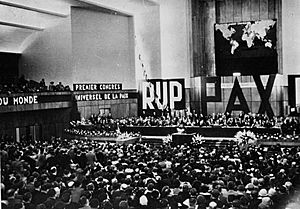
Belgium wanted to stay neutral and avoid another war. After World War I, Germany had violated Belgium's neutrality. Belgium feared being drawn into a new conflict. They were especially worried about a German attack through their country.
Belgium had built strong defenses along its border with Germany. These included modern forts at Namur and Liège. They also had new defense lines along the Albert Canal. The Belgians hoped these defenses would slow down any German attack. This would give the Allied armies time to arrive and help.
Allied Strategy for Belgium
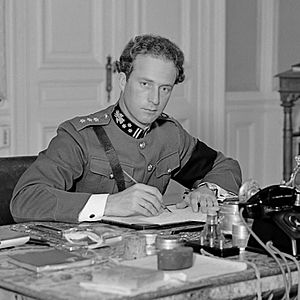
The Allies (France and Britain) had a plan called the Dyle Plan. This plan involved sending their best forces, including French armored divisions, into Belgium. They would meet the Germans at the Dyle river. The goal was to stop the German Army far from the French border.
However, Belgium's decision to remain neutral made things difficult. The Belgians did not want to openly cooperate with the French or British military. They feared this would make them a target. Despite this, Belgium secretly shared some defense information with France.
The British military was not as strong as the French at this time. They mostly agreed with the French strategy. The British also planned to use their air force to bomb German industries.
Germany's Attack Plan
Germany's main plan, Fall Gelb, involved two army groups. Army Group B would attack Belgium and the Netherlands. Its job was to draw the main Allied forces into Belgium. Meanwhile, Army Group A would launch a surprise attack through the Ardennes forest. This group would then race to the English Channel, trapping the Allied armies.
To make this plan work, Germany needed to quickly capture key bridges over the Albert Canal in Belgium. These bridges were vital for Army Group B to advance. The most important target was Fort Eben-Emael. This strong Belgian fort guarded the bridges.
To capture the fort quickly, the Germans used a new tactic. They deployed special airborne forces called Fallschirmjäger (paratroopers). These soldiers landed inside the fort using gliders. They used special explosives to disable the fort's defenses. This was the first time such a strategic airborne operation was attempted.
Military Forces Involved
Belgian Army
The Belgian Army had about 600,000 soldiers. They had 22 divisions, including infantry and specialized units like the Chasseurs Ardennais. They had 1,338 artillery pieces.
Their tanks were limited. They had 10 AMC 35 tanks and about 200 T-13 tank destroyers. The T-13s had powerful 47mm anti-tank guns. They also had 42 T-15s, which were light tanks with machine guns. The Belgian anti-tank guns were considered better than those of the French or Germans.
The Belgian Air Force (AéMI) was still modernizing. They had about 250 combat aircraft, but only 118 were ready for battle on 10 May 1940. Most of these were older models.
French and British Forces
The French Army provided significant support. The French First Army included strong armored units like the 2nd and 3rd Light Mechanized Divisions. These divisions had 176 SOMUA S35 tanks and 239 Hotchkiss H35 light tanks. These tanks were generally better armored and had more firepower than most German tanks.
The French Seventh Army was sent to the northern part of the Allied front. It was supposed to advance into the Netherlands. The French Ninth Army was weaker and protected the southern flank of the Allied armies.
The British Expeditionary Force (BEF), led by General Lord Gort, was the smallest Allied force in Belgium. It had about 152,000 men in two corps. By May 1940, the BEF had 10 divisions, 1,280 artillery pieces, and 310 tanks. The Royal Air Force (RAF) also provided air support.
German Forces
Army Group B, commanded by Fedor von Bock, had 26 infantry divisions and three Panzer (tank) divisions for the invasion of Belgium and the Netherlands. The 3rd and 4th Panzer Divisions were key to the attack in Belgium.
In total, Army Group B had 808 tanks. Many were lighter Panzer Is and Panzer IIs. They also had 123 Panzer IIIs and 66 Panzer IVs, which were more powerful. The Germans used radio communication between their tanks, which gave them a big advantage.
The Luftwaffe (German Air Force) was very strong. It had 1,815 combat aircraft and 487 transport planes for the invasion. They aimed to destroy the Belgian Air Force and support ground troops.
The Battle Begins
Air Attacks and Border Fights: 10–11 May
On 10 May 1940, the Luftwaffe launched massive air raids against Belgian airfields and communication centers. The Belgian Air Force, with only 179 aircraft, suffered heavy losses. Many Belgian planes were destroyed on the ground.
At the same time, German paratroopers attacked Fort Eben-Emael. Using gliders, they landed directly on the fort's roof. They quickly disabled its defenses with special explosives. This allowed German infantry to cross the Albert Canal and break through the main Belgian defense line.
Further south, German airborne units also landed in Luxembourg to secure routes into Belgium. Another airborne operation, Operation Niwi, aimed to clear paths for German Panzer divisions advancing through the Ardennes. This operation caused some confusion and delays for both sides.
The Belgians tried to bomb the captured bridges over the Albert Canal on 11 May. However, German fighters and anti-aircraft guns were too strong. The RAF and French Air Force also tried to attack the bridges but suffered heavy losses.
By the evening of 11 May, the Belgian 4th and 7th Infantry Divisions had to retreat from the Albert Canal. The Germans had broken through, threatening to surround the Belgian forces. The Belgians pulled back to the Namur–Antwerp line.
Battles in Central Belgium: 12–14 May
On 12 May, Allied commanders met near Mons. They agreed that the Belgian Army would defend the Antwerp–Leuven line. The British and French would cover the northern and southern parts of the country.
The most important battle in central Belgium was the Battle of Hannut (12–14 May). German Panzer divisions, led by General Erich Hoepner, attacked the Gembloux gap. This was an open area without strong defenses. The French 1st Army, with its elite armored divisions, defended this gap.
The French and German tanks clashed near Hannut on 12 May. The French had powerful tanks like the SOMUA S35. The Germans had more tanks overall, but many were lighter models. The Germans used better tactics, like radio communication and combined arms (tanks, infantry, air support). The French tanks often lacked radios, making coordination difficult.
On the first day, the French fought well and stopped the German advance. Many German light tanks were destroyed. However, on 13 May, the French spread their tanks too thinly. This allowed the Germans to concentrate their forces and break through. The French had to retreat from Hannut.
Hoepner's Panzer Corps continued to push the French back towards Gembloux. The Germans suffered heavy losses in tanks during these battles, but they were able to repair many of them. The French 1st Army also took heavy damage. Although the French won some tactical victories, they were forced to retreat on 15 May because of German breakthroughs elsewhere.
Retreat to the Coast
Counterattacks and Retreat: 15–21 May
On 15 May, German Army Group A broke through at Sedan in France. This meant they could now drive straight to the English Channel. The Allies realized they were in danger of being trapped in Belgium. They began to plan a major withdrawal.
The Belgian Army, the BEF, and the French 1st Army were ordered to retreat on 16 May. They needed to avoid being surrounded by the German armored forces. The Belgians had held their line well against the German 6th Army. However, the collapse of the French 2nd Army at Sedan changed everything.
The Belgians had to abandon Brussels and Leuven. The Belgian government fled to Ostend. Brussels was occupied by the German Army on 17 May. The German 3rd and 4th Panzer Divisions, which had fought at Hannut and Gembloux, were then sent to support Army Group A's push to the Channel.
By 19 May, the Germans were very close to the French Channel coast. The British commander, Lord Gort, realized the French had no plan or reserves to stop the German advance. The BEF's position in Belgium was now very risky. They considered retreating to the Channel ports like Dunkirk.
The British government ordered Gort to launch an attack to the south-west to link up with French forces. The Belgian Army was asked to join this attack. However, King Leopold III stated that the Belgian Army could only defend. It lacked tanks and aircraft for offensive operations. He warned that such an attack would overstretch the Belgians and lead to their collapse. Leopold suggested focusing on defending a small area around Dunkirk and the Belgian Channel ports.
Despite this, the British launched a small attack at Arras on 21 May, which failed. The Belgians were then asked to fall back to the Yser river to protect the Allied left flank. The Belgian Army was exhausted and could not make such a move without falling apart.
Final Defensive Battles and Surrender: 22–28 May
By 22 May, the Belgian front stretched for about 90 kilometers. The BEF and French forces were moving west to protect Dunkirk. The Belgians were left to hold the eastern front along their last fortified position at the Leie river.
On 23 May, the Germans captured Terneuzen and Ghent. The Luftwaffe had complete control of the air. This made it very difficult for the Belgians to move supplies.
On 24 May, a dangerous gap opened between the British and Belgian forces near Ypres and Menen. The Belgians could not cover it. Lord Gort, without consulting the French or his government, ordered two British divisions to fill this gap. This meant abandoning any offensive plans to the south.
On the afternoon of 24 May, the German 6th Army attacked the Belgian position at Kortrijk on the Leie river. The Germans managed to cross the river, despite fierce Belgian resistance. The Belgians fought hard, inflicting many casualties on the Germans. However, the Germans had more soldiers and air support. The Belgian artillery and infantry were heavily attacked by the Luftwaffe.
The Belgian High Command repeatedly asked the British to counterattack the German flank to help them. However, no such attack came. The Germans brought in fresh troops, almost cutting off the Belgians from the British.
On 26 May, Operation Dynamo officially began. This was the evacuation of British and French troops from Dunkirk to the United Kingdom. By this time, the Germans had reached Dunkirk, bringing the port within artillery range.
The fighting on 26–27 May pushed the Belgian Army to its breaking point. Their front collapsed in the Izegem–Thelt sector. This left nothing to stop a German advance to take Ostend and Bruges, or the ports at Nieuwpoort or La Panne. The Belgians had almost no way left to resist.
Belgian Surrender
By the evening of 27 May, the Belgian Army was stretched thin. They had no reserves. The Luftwaffe controlled the skies, making retreat impossible without heavy losses. Water, gas, and electricity supplies were cut. The remaining free area was small and crowded with soldiers and three million civilians.
Under these conditions, King Leopold III decided that further resistance was useless. He requested an armistice (a ceasefire). The Belgian surrender became effective at 04:00 on 28 May.
The British and French reacted strongly, claiming the Belgians had betrayed the alliance. French Premier Paul Reynaud denounced Leopold's surrender. The Belgian Premier Hubert Pierlot announced that Leopold had acted against the government's advice. As a result, the Belgian government-in-exile continued the fight from Paris (later London).
However, these accusations were largely unfair. The Allies had known that the Belgians were close to collapse. King Leopold III did not sign an agreement with Hitler. He signed an unconditional surrender as the Commander-in-Chief of the Belgian Armed Forces.
Casualties
The exact number of casualties for the Battle of Belgium alone is hard to know. These figures include losses for the entire campaign from 10 to 28 May 1940.
Belgian Losses
- Killed in action: 6,093 soldiers.
- Died in captivity: 2,000 prisoners.
- Missing: More than 500.
- Captured: 200,000.
- Wounded: 15,850.
- Aircraft destroyed: 112.
French Losses
Exact numbers for the Battle of Belgium are not known. For the entire Western Campaign (10 May – 22 June):
- Killed in action: 90,000.
- Wounded: 200,000.
- Prisoners of War: 1,900,000.
- Aircraft losses: 264 (12–25 May), 50 (26 May – 1 June).
British Losses
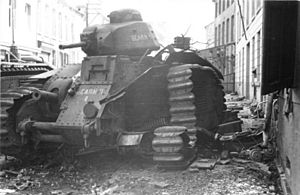
Exact numbers for the Battle of Belgium are not known. For the entire campaign (10 May – 22 June):
- Total killed, wounded, or captured: 68,111.
- Vehicles destroyed or abandoned: 64,000.
- Guns destroyed or abandoned: 2,472.
- RAF aircraft losses: 931 (10 May – 22 June).
German Losses
According to German reports for operations from 10 May to 4 June:
- Killed in action: 10,232 officers and soldiers.
- Missing: 8,463 officers and soldiers.
- Wounded: 42,523 officers and soldiers.
- Luftwaffe aircraft losses: 432 (10 May – 3 June).
Images for kids
-
German soldiers entering Eupen-Malmedy, a German border region that had been part of Belgium.
-
Destroyed French tanks in Beaumont on 16 May.
 In Spanish: Batalla de Bélgica para niños
In Spanish: Batalla de Bélgica para niños
See also
- German invasion of Luxembourg
- Mechelen incident
- List of Belgian military equipment of World War II
- List of French military equipment of World War II
- List of British military equipment of World War II
- List of German military equipment of World War II


